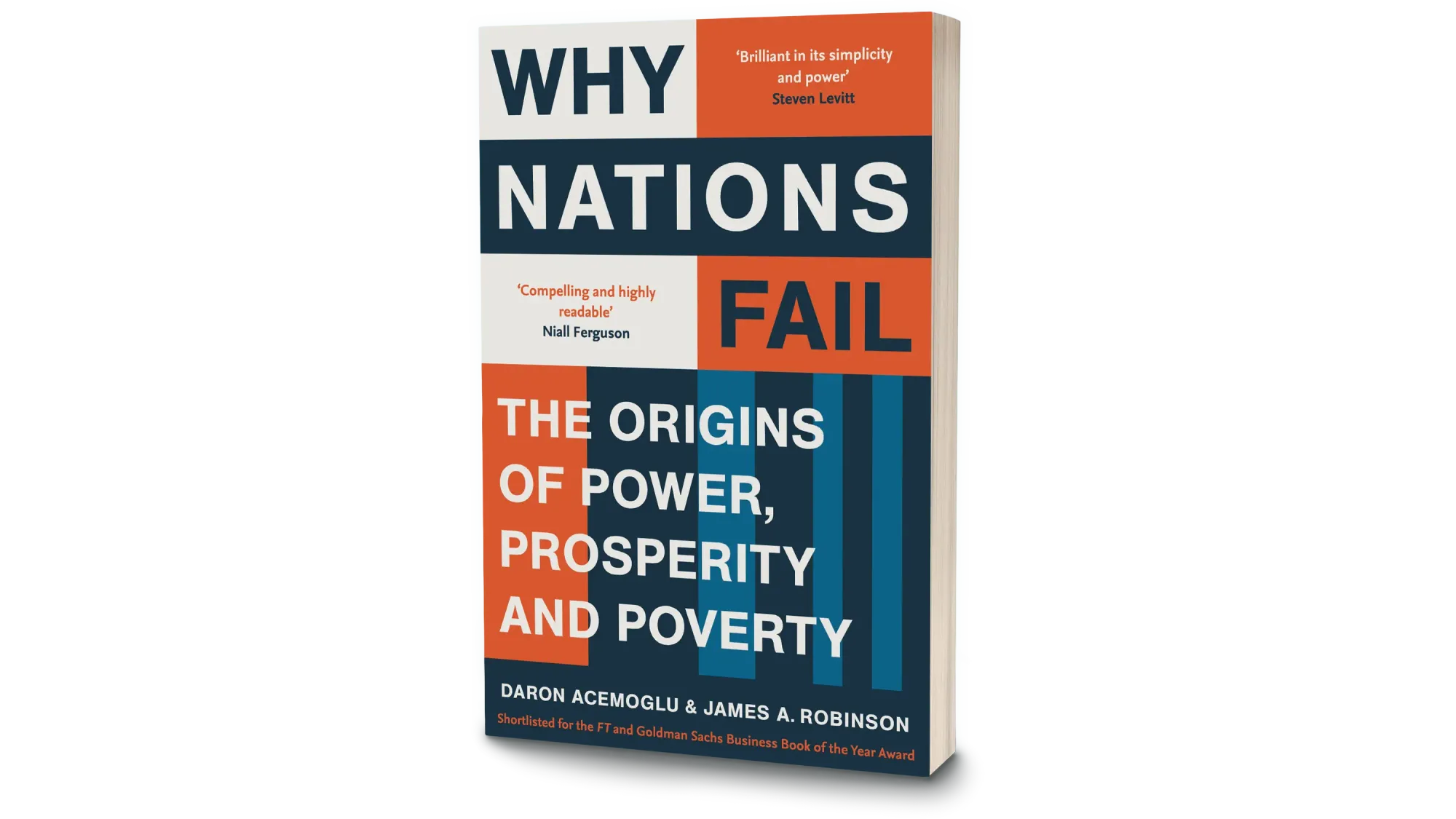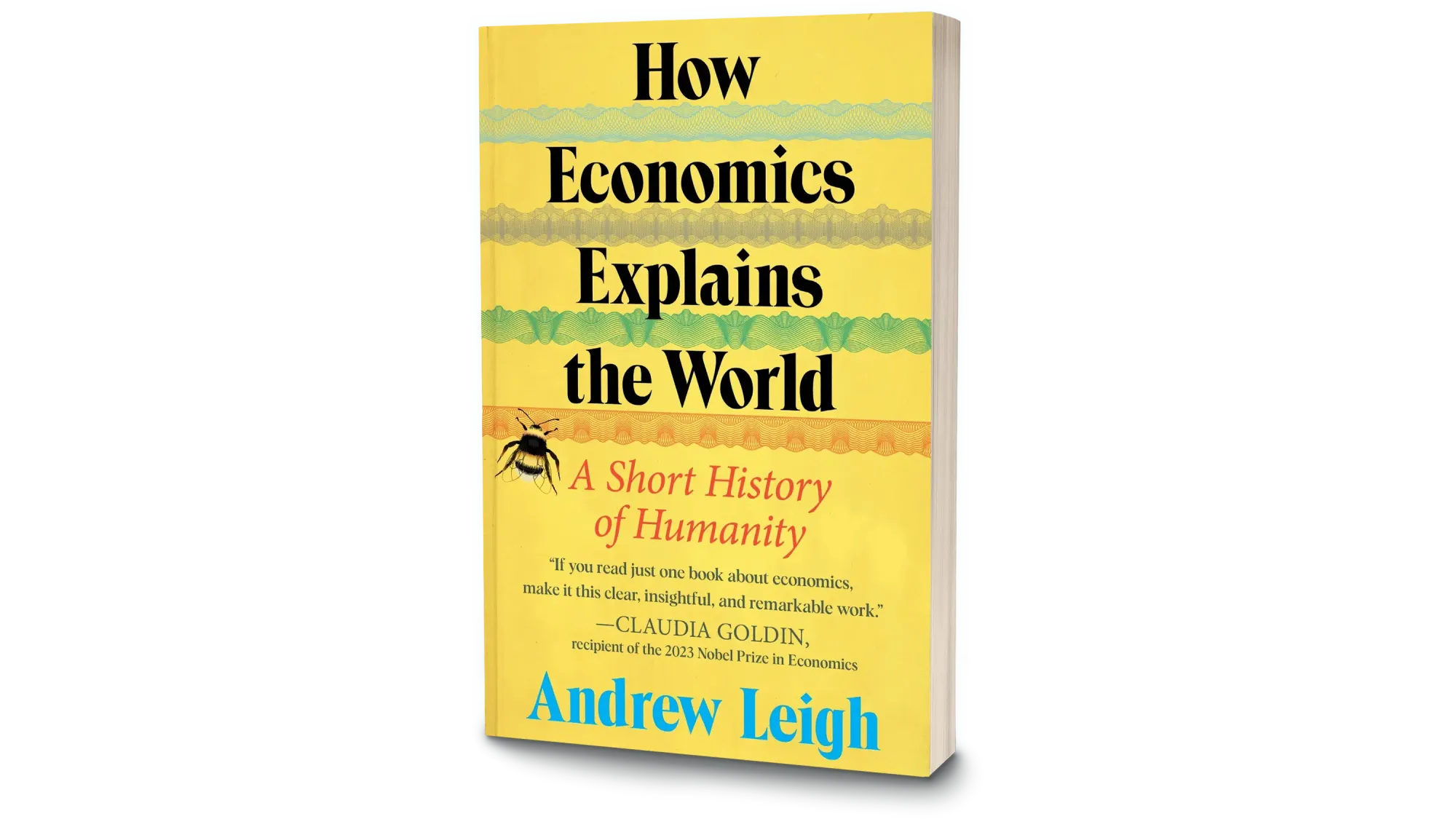The Rise and Fall of Nations

A review of Why Nations Fail: The Origins of Power Prosperity and Poverty by Daron Acemoglu and James A. Robinson (2012, Currency/Penguin Random House) and How Economics Explains the World: A Short History of Humanity by Andrew Leigh (2024, Mariner Books/Harper Collins)
How useful can economics be in explaining past or present society? Economists Daron Acemoglu and James A. Robinson won the 2024 Nobel Memorial Prize in Economic Sciences for their earlier technical work explaining why some countries are poor and in chaos while others are rich and stable. They packaged all this technical information into a book: Why Nations Fail: The Origins of Power, Prosperity, and Poverty. The authors argue that new technology is necessary for economic growth (the creation of new products), but to create economic growth a number of factors are required, such as political stability, consistent standards of law, and sound infrastructure. Acemoglu and Robinson argue that people are unlikely to start a business, and therefore create economic growth and prosperity, if they can’t get their goods to market; if government taxes, regulations, or corruption make it too expensive to make a profit; or if lawlessness or government actions are too arbitrary, exploitive, or inconsistent. The authors give examples from across centuries and continents, from 16th century Central America to late 20th century Africa.
Why Nations Fail argues that it is government leaders who primarily determine whether nations succeed. They phrase this as whether economic and political institutions are inclusive (good for the many) or extractive (good for the few). Going a step further, the authors argue that this is well known and is therefore a choice—nations choose to succeed or fail.

This thesis, if true, means that other theories of why nations become poor or rich are incorrect, including those focusing on geography or culture. The authors address these alternative theories head on early in the book. By looking at examples of neighboring locales with similar geography but where relative prosperity used to be equal or even swapped from what it currently is, the authors conclude that geographic explanations (such as those suggested by Jared Diamond), especially for the modern era, do not appear correct. Examples include a town that is half in Mexico and half in the United States and the effect on Korea of its political division into North and South (differences that can be observed from space in which one is brightly lit and vibrant while the other is dark and dying).

Another theory—culture—is seen mostly as a product rather than a cause of economic differences. The authors concede that most people in their profession view ignorance of good policy as the prime cause of economic disparity between countries. This seems to weaken their argument that leaders who make economic decisions that are bad for their countries are necessarily doing it out of ignorance, but Acemoglu and Robinson are firm in their stance.
Their case seems to be built on their many examples of countries where leaders enrich themselves at the expense of the population, thereby choosing against economic and political changes that would benefit the country as a whole. Are there current countries where economic policy hurt the country without benefiting the ruler? There are dozens, but among the most well-known were England, the U.S. colonies, and France’s wider prosperity after diminishing the power and wealth of monarchies in the 17th, 18th, and 19th centuries respectively. European colonialism of Africa, South America, and Asia receives a similar critique.
Readers will be stimulated by the striking connections between the politics, economics, and history of various nations
There is plenty of material in Why Nations Fail that will appeal to both liberals and conservatives. For example, liberals may appreciate the authors’ criticisms of wealth disparity and praise of infrastructure spending, and their arguments in support of at least some grass roots protest movements, such as the 1960’s U.S. Civil Rights movement. But the authors are not leftist ideologues, as they also criticize over-taxation, while praising law and order and property rights. The authors note that wealth rankings between regions of the Americas have been remarkably steady for a century, which may stymie leftist critics who want to blame U.S. military intervention or trade agreements for the disparity.
There’s a lot to praise in Why Nations Fail, but much to critique as well. On the one hand, on any page, readers will be stimulated by the striking connections between the politics, economics, and history of various nations, and the authors’ thesis and supporting arguments are easy to follow as they repeat their main points throughout the book. On the other hand, I can’t think of another book that possesses these qualities and is still so difficult to read. For example, the authors’ discussion of a region or country at a particular time in history that goes on for several pages before they explain the lesson to be learned, and then sometimes in greater detail than is needed to make the point. Worse, although the chapters are nominally thematic, the point they are trying to make with a given anecdote often turns out to be one that would have fit better in another chapter under a different theme.
To their credit, Acemoglu and Robinson do occasionally give examples that might counter their thesis, including countries that had both extractive and inclusive institutions at the same time; at least one case where one type of change “should have” led to the other; and several cases of the role of “contingency” in changing the course of history. Although the authors repeatedly say that prosperity under extractive institutions is unsustainable, some of their examples of this are already decades old, so what is their definition of “sustainable”? More fundamentally, I wonder if their extraordinarily wide range of places and times could at least occasionally exemplify their choosing examples which fit their thesis? Since Why Nations Fail presupposes that leaders do not choose bad economic policies out of ignorance, the authors’ argument might have benefited from a more nuanced discussion of debates within the economics profession as well as an acknowledgement of cognitive biases.

Finally, Why Nations Fail also contains a few ancillary comments that Skeptic readers might appreciate. One is the range of scientific data on offer, including a few mentions of archaeological or genetic evidence, and even one of ice core samples. More fun for skeptics, there is one case where—to make a point—the authors mention a supposedly supernatural oracle that changed its prognostications to align with socio-political changes in the area. There is also at least one comment by the authors that seems prescient, since it was made more than a decade ago: that immigration (including across the Rio Grande river from Mexico), “causes grievances and resentment, with huge political consequences in the U.S.” This in a book published in 2012!

In How Economics Explains the World: A Short History of Humanity, Andrew Leigh agrees on economic growth coming from technology rather than social mores, and that it will be greater if there is institutional support of technology and education. Leigh likewise offers economic analyses of historical events, such as the Black Death leading to the end of feudalism, the economic impact of the mid 20th century division of Korea, Stalin’s violent reaction to a census that did not report what he wanted it to, and that wars are usually won by the side with the larger economic base.
Leigh gives a bit more credence to geography as impacting economic success than what is on offer in Why Nations Fail, and also draws fewer examples outside of England and the United States. Leigh integrates remarkably clear explanations of economic concepts and, often, introduces the economists who championed them. Unlike Acemoglu and Robinson, Leigh does not have a thesis per se, and when he notes disagreements among economists, his point of view, when discernible, is stated modestly.
Each chapter of How Economics Explains the World includes sidebars on economic concepts or events (such as the impact of the mid 1950s adoption of the standardized shipping container), or on a topic not typically viewed through an economic lens (such as sports or genius). Meanwhile, Leigh writes a mostly chronological narrative hitting all the expected high spots, from ancient cities to the circa 16th century age of exploration to the early 20th century rise of the assembly line. To do all of this while still being one of the most lucid books I’ve ever read is remarkable. (For most books I read, I often imagine myself rewriting sentences for clarity, but I never did so in this book.)
Though not central to the book, readers of Skeptic will likely share my amusement at a case cited by Leigh in which chimpanzees fared as well as Wall Street professionals in predicting successful stocks—the problem of unpredictability being one that he returns to, briefly, later in the book. (For the curious, an entire book arguing that long term prediction is impossible in any field is 1998’s The Fortune Sellers by William Sherden, reviewed in Skeptic, Vol. 6, No. 3). Readers of Skeptic might be surprised by his critiquing the “good tale” of tulip mania as a bubble, but especially appreciate Leigh’s support for behavioral economics and his mention of Max Roser on the impact of news coverage, and of Steven Pinker’s highlighting the increase in living standards. Indeed, one theme of the book is how widespread and useful economic analysis can be (he even has a sidebar on the economics of beauty). I especially appreciated Leigh’s concise discussion of the creation and benefits of double-blind studies in science, and its emigration (with adaptation) to economics.
I can see the world more clearly from having read these books.
Anyone in 2025 will find topicality in Leigh’s mention of how vaccinations have benefitted societies, and in his dig that “It is a mistake to see migrants merely as a new source of demand—they are also a new source of supply.” But most of the book’s discussions are more general and fundamental. For example, the historic rise in living standards is credited to the basic economic concept that business specialization is to everyone’s advantage. It may be obvious that it makes more sense to find one job than to try to make everything yourself, but a logical extension of this, according to Leigh, is that it also makes more sense for geographic areas to specialize in what they are skilled in or have especially rich resources in. This support of free trade recurs in the book (it is a tribute to Leigh’s skill that I painlessly learned that these twin concepts are called “comparative advantage”).
While my main critique of Why Nations Fail was stylistic, I am amazed that I have no significant general critiques of How Economics Explains the World (though I might if I were an economist). That said, both books omit some relevant material. I would have liked to hear Acemoglu and Robinson’s critique of the liberal trope of the wealth disparity in the U.S. relative to other industrialized countries. Similarly, I wish Leigh had addressed (and perhaps critiqued) the emerging argument that private equity firms are distorting markets without societal benefit (such as by buying vast numbers of houses for investment purposes, or their alleged role in the demise of some popular casual dining chains).
Quibbles aside, I feel like I can see the world more clearly from having read these books. Why Nations Fail was as stimulating as it was frustrating. How Economics Explains the World is a gem; simply amazing that it is so easily informative on such a wide area, all in less than 200 pages of main text.